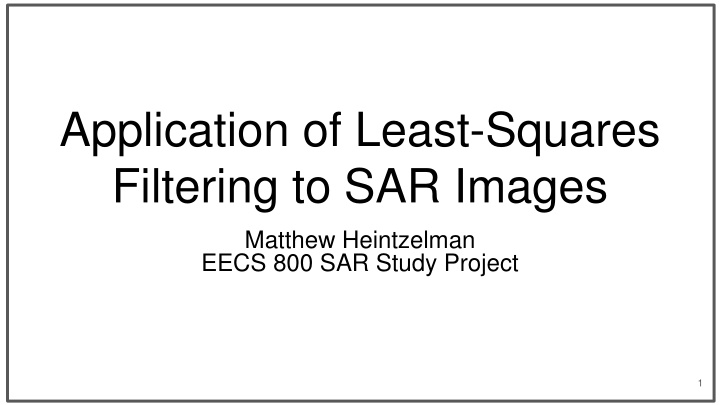
Advanced Least Squares Filtering for Improved SAR Image Processing
Explore the application of Least-Squares Filtering to SAR images for enhanced sidelobe response and minimal resolution degradation. Learn about adapting the Least Squares Optimal Mismatch Filtering technique to SAR data and various filtering strategies for improved SAR processing.
Download Presentation

Please find below an Image/Link to download the presentation.
The content on the website is provided AS IS for your information and personal use only. It may not be sold, licensed, or shared on other websites without obtaining consent from the author. If you encounter any issues during the download, it is possible that the publisher has removed the file from their server.
You are allowed to download the files provided on this website for personal or commercial use, subject to the condition that they are used lawfully. All files are the property of their respective owners.
The content on the website is provided AS IS for your information and personal use only. It may not be sold, licensed, or shared on other websites without obtaining consent from the author.
E N D
Presentation Transcript
Application of Least-Squares Filtering to SAR Images Matthew Heintzelman EECS 800 SAR Study Project 1
Background: Typical SAR image formation algorithms produce relatively high sidelobes (fast-time and slow-time) that contribute to image speckle and can mask scatterers with a low RCS. Standard method for improving sidelobe response is amplitude-only tapering (both pulse and aperture tapering). Tradeoff is degraded resolution We should be able to improve the sidelobe response with minimal resolution degradation via advanced filtering techniques. 2
Background: There has been relatively little work on alternatives to MF for SAR processing [1] explores a SAR implementation of Adaptive Pulse Compression to provide moderate improvement for range compression over the MF As a first step to adapting more complicated filtering strategies, I plan to adapt the Least Squares Optimal MisMatch Filtering (MMF) technique in [2] to SAR data. Here I explore three strategies based on back projection algorithm. Naive Least Squares Filtering Range-Azimuth coupled Least Squares Filtering Focused Least Squares 3
Least Squares Filtering: The standard least squares filtering approach follows the model: Ah = em Where A is the convolution matrix formed by filter input s, h is the LS MMF, and emis the mth elementary vector In general, the system is overdetermined, and the solution is found via the pseudoinverse: h = (AHA)-1AHem In practice this problem can be ill-conditioned, and regularization based on the eigenvalues of AHA should be used [2]. 4
Least Squares Filtering: LS MMF applied to LFM from HW 3 For the MF: Peak Sidelobe Level = -13.45 dB Integrated Sidelobe Level = -9.71 dB For the LS MMF: Peak Sidelobe Level = -36.31 dB Average Sidelobe Level (relative to mainlobe) = -32.42 dB Mismatch loss = 0.0045 dB Note the spurious sidelobes that appear for the LS solution ([2] contains strategies to help) 5
Naive Least Squares (Strategy 1): Here, the slow-time fast-time coupling is not directly addressed 2D filter is formed by computing the outer product between LS MMFs Fast-Time MMF is based on complex-baseband signal Slow-time MMF is based on slow-time chirp due to phase hyperbola Total MMF is then phase shifted according to the delay experienced at each pixel. This approach works quite well for fast-time compression, but not slow-time Here, FT PSL decreases from about -13 dB to -20 dB (Sidelobes also fall off faster) 6
Naive Least Squares (Strategy 1): Slow-time compression fails for strategy 1 because slow-time signal is windowed and resampled for each pixel each pixel Slow-Time Signal: exp(j2?fc?delay) 7
Naive Least Squares (Strategy 2): Slow-time compression fails for the previous strategy because slow-time chirp is multiplied with a sliding window and resampled at each pixel the slow-time signal received from each pixel is different and should be filtered differently The obvious strategy is to generate a new slowtime LS MMF for the slow-time chirp observed due to each pixel in the scene. Much more computationally expensive, but feasible for smaller simulations Decreases peak sidelobe level, but smears the sidelobe energy, raising overall sidelobe levels. ST PSL = -16 dB, FT PSL = -20 dB 8
Range-Azimuth Coupled LS Post-Filtering: The ideal LS solution would be to generate a new 2d LS filter for each pixel in the scene. Provides the benefits of LS MMF and correctly models Range-Azimuth coupling Incredibly expensive to perform, even for the small scene discussed in class (HW 3) Here, two steps are taken to reduce the computational load First, standard matched filtering is performed to reduce the amount of two dimensional data to the scene of interest Second, the match-filtered data is tiled to provide more quickly compute the pseudo-inverse for a second stage of filtering (current tiling keeps the main lobe and first 3 sidelobes). This technique uses a LS post-filter to attempt to suppress the sidelobes of the matched filter response. Currently debugging this code 9
Range-Azimuth Coupled LS Post-Filtering: Code is not working properly, but here is the current output of the post filter (in case you re curious): Raw Phase History MF SAR Image Sidelobe-Suppressed SAR image Match Filter LS Post- Filter Receiver 10
Focused Least Squares Filtering: Fast-Time LS filtering will be performed according to the Naive approach. Slow time Filtering will be performed as follows: from a Fast-Time dependent synthetic array factor, compute a slow-time taper for each pixel that focuses on that pixel. Apply taper to received data during filtering step Still a 2d filtering technique, but I might be able to find a taper that s simpler to compute than the pseudo-inverse. Slow-Time compression should be similar to wideband beamforming [3,4] 11
Sources: [1] Focusing SAR Imagery, IEEE Transactions on Geoscience and Remote Sensing, vol. 55, no. 4, April 2017 E. Dominguez, C. Magnard, M. Frioud, D. Small, E. Meier Adaptive Pulse Compression for Range [2] and Adaptive Pulse Compression for FM Waveforms," IEEE Intl. Radar Conf., Washington, DC, 11-15 May 2015, D. Henke, P. McCormick, S.D. Blunt, and T. Higgins, "Practical Aspects of Optimal Mismatch Filtering [3] Design with Space-Frequency Nulling," IEEE Journal of Selected Topics in Signal Processing, vol. 11, no. 2, pp. 363-378, Mar. 2017 P.M. McCormick, S.D. Blunt, and J.G. Metcalf, "Wideband MIMO Frequency-Modulated Emission [4] MIMO Radar Emissions," IEEE Radar Conf., Philadelphia, PA, 2-6 May 2016 P.M. McCormick, S.D. Blunt, and J. Metcalf, "Joint Spectrum/Beampattern Design of Wideband [5] Electronic Systems Magazine, vol. 31, no. 11, pp. 2-42, Nov. 2016, DOI: 10.1109/MAES.2016.160071. S.D. Blunt and E.L. Mokole, "An Overview of Radar Waveform Diversity," IEEE Aerospace & 12
Questions: 13




